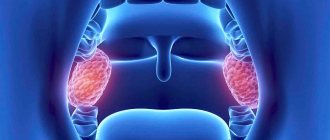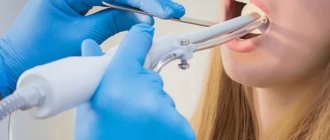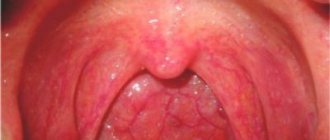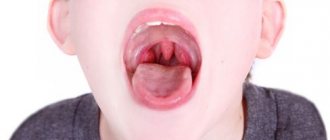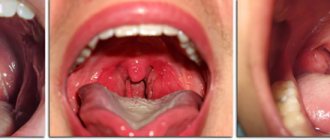What are lacunae
The tonsils are covered on the outside with a mucous membrane with depressions called lacunae. They protect the body from pathogens and ensure filtration of everything that enters the mouth.
In the follicles that make up the tonsils, lymphocytes mature and are released onto the surface of the lacunae to destroy microbes. In a healthy person, the lacunae cleanse themselves.
Why is rinsing prescribed?
When immunity decreases, the production of lymphocytes decreases, and an inflammatory process begins in the lacunae. As a result of the disease, the ability to cleanse itself decreases and the recesses of the tonsils become clogged with purulent plugs.
The person’s health deteriorates and the following appears:
- heat,
- severe sore throat
- difficulty swallowing.
With frequent such manifestations, doctors diagnose chronic tonsillitis. And rinsing is prescribed to prevent the spread of infection to other organs.
This stops the exacerbation of tonsillitis and in some cases eliminates the need for surgical intervention to remove the tonsils. Washing is almost painless, as doctors use modern equipment to carry it out quickly.
Important! It is dangerous to clean lacunae on your own due to the risk of damaging the delicate mucous membrane of the palate and pharynx.
Symptoms of tonsillitis
Clinical manifestations are quite varied and depend on the type of tonsillitis. The disease debuts acutely, against the background of hypothermia or stress. First there is a sore throat. It may intensify when swallowing, after smoking, or eating hard, dry foods. There is a cough, a feeling of a foreign body in the throat, rawness, soreness in the throat. The body temperature rises, the patient feels weak, tired, unwell, quickly gets tired, and there is pain in the joints and muscles. Upon examination, the doctor reveals enlarged and painful submandibular and cervical lymph nodes; the pharyngoscopic picture varies from hyperemia of the tonsils to friability, purulent changes (lacunae and follicles), and enlarged tonsils. The mucous membrane becomes swollen. In the presence of purulent plaque, a characteristic unpleasant odor from the mouth may appear.
Treatment for tonsillitis depends on its type and cause. Let's look at it in detail:
Etiotropic treatment (impact on the cause of the disease) depends on the causative agent of the disease. If a sore throat is bacterial in nature and if there are indications, antibiotics are used, which are prescribed by a doctor. Self-treatment of tonsillitis with antibiotics is not recommended, since an insufficient dose or the wrong choice of drug can lead to the development of resistance (persistence) in the microorganism, as well as to complications of angina (for example, peritonsillar, retropharyngeal abscess, diphtheria croup in children, acquired heart defects). For a viral infection, symptomatic therapy is prescribed, as the patient’s general condition remains satisfactory. Physiotherapy methods are also effective: ultraviolet irradiation increases the barrier function, the resistance of the tonsils, improves, stimulates local and general immunity, and has an antimicrobial effect. Laser treatment of tonsillitis in the submandibular area is carried out daily, in a course. The therapeutic effect is achieved by dilating small blood vessels and increasing blood circulation in the area of inflammation1.
Symptomatic treatment
Anti-inflammatory drugs (paracetamol, ibuprofen, aspirin) have proven themselves well in the treatment of tonsillitis. They reduce swelling, inflammation, and as a result, pain. Antihistamines (Zyrtec, Tavegil) and analgesics are also used. For the duration of treatment, smoking, drinking alcohol, and spicy and hot foods are excluded. A gentle diet and bed rest are prescribed for 5-7 days.
If the patient’s general condition does not suffer, we can limit ourselves to the use of local means of treating tonsillitis.
Local treatment consists of prescribing medications that have an antiseptic, anti-inflammatory, and analgesic effect2. Drugs for local therapy should not only relieve sore throat, but also have a wide spectrum of antibacterial activity, low allergenicity, and be non-toxic.
Hexoral ® has all these properties. The drug is active against a wide range of gram-positive bacteria, as well as pathogenic fungi of the genus Candida; the drug Hexoral ® can have its effect in the treatment of infections caused by Pseudomonas aeruginosa and Proteus. At a concentration of 100 mg/ml, the drug inhibits the growth of most bacterial strains. Hexetidine, being the active ingredient of the drug Hexoral ®, also has an anesthetic effect on the mucous membrane3. The variety of dosage forms of Hexoral ® makes its use accessible to the whole family. Hexoral ® spray is a convenient, effective and proven form for the treatment of tonsillitis in adults and children from 3 years of age. The Hexoral® line also includes a rinse solution (from 3 years old), Hexoral® tabs tablets (from 4 years old), Hexoral® tabs Classic (from 6 years old), Hexoral® tabs Extra (from 12 years old) years). In the form of a rinse solution, lozenges and sprays, the medicine is convenient to use, which makes patient adherence to treatment high.
In all cases of tonsillitis, it is necessary to consult a doctor, so that only a specialist can prescribe adequate treatment and prevent complications.
Surgery
Tonsillectomy is the removal of tonsil tissue and the underlying capsule. It is used in cases of unsuccessful conservative therapy, in the presence of a focus of chronic infection in the tonsils. A tonsillectomy is performed by an ENT doctor. Before the operation, you should consult with a therapist, do blood and urine tests, perform an ECG, and a chest x-ray. If there are concomitant diseases, undergo additional examination by specialized specialists.
Tonsillectomy is usually performed under local anesthesia with the patient sitting. Local anesthesia is performed, and then the tonsils are removed along with the capsule. The operation does not last long, about 10 minutes, complications are quite rare. Indications for surgical treatment are chronic persistent inflammation of the palatine tonsils in the stage of decompensation, frequent exacerbations of chronic tonsillitis, purulent complications in the form of abscesses and phlegmon.
Contraindications for tonsillectomy are: blood diseases (hemorrhagic diathesis), neuropsychiatric diseases in the stage of decompensation, which can interfere with the course of the operation and compliance with the postoperative regimen, open form of respiratory tuberculosis, cardiac, renal failure, severe diabetes mellitus. In each specific case, the issue of performing an operation is decided individually1.
Cryotherapy is a gentle method of semi-surgical treatment. Cryotonsillotomy - exposure to the tonsils with a special applicator (cryoprobe), in a closed system of which liquid nitrogen circulates at a temperature of -196 °C4. Areas of chronic inflammation where the tonsil no longer performs its functions are removed. Since cryotherapy is painless and bloodless, it is the method of choice for weakened patients, patients with blood diseases and those for whom surgical treatment is contraindicated (allergy to novocaine, severe diabetes mellitus, uncontrolled hypertension, severe heart failure, renal failure, hemophilia) and also in children. After cryodestruction, the body recovers more quickly and the patient returns to normal life. However, along with the advantages, the cryosurgical method has a number of disadvantages: several stages are assumed over 1.5 months, but in some cases it is not possible to achieve complete removal of tonsil tissue.
Contraindications to cryotherapy: decompensation of diabetes mellitus, some oncological diseases, acute myocardial infarction, high-grade heart failure, severe hypertension.
Up to contents
Types of washing
Purpose of appointment: to remove pus from the lacunae and treat them with a drug. After this, the patient's condition improves significantly.
Specialists carry out the procedure in different ways:
syringe. A solution is drawn into a 20-gram syringe. Instead of a needle, a special nozzle with a curved end is put on so that the solution falls directly on the stopper. The liquid under the pressure of the piston is fed into the lacuna and flushes it.
Washing the tonsils- Vacuum method of washing tonsils . The tonsils are anesthetized, a vacuum suction cup is attached to them, through which the purulent contents are pumped out. After this, the medicinal composition is pumped into the lacuna.
- Ultrasonic washing of tonsils . The cleaning principle is based on a combination of cavitation and ultrasound. Air bubbles form in the washing liquid, and when they rupture, the membranes of microbial cells are damaged.
The Kuntsevo Medical Center has modern otolaryngological equipment, which allows the operation to be performed as quickly, efficiently and painlessly as possible.
Why do you need to rinse your tonsils?
Human tonsils (tonsils) have a special structure. They have deep slits (ducts) called lacunae. This is a place where different types of bacteria accumulate and where drainage is impaired. Food debris, dead epithelial cells and microorganisms that decompose organic matter contribute to the formation of plugs in the lacunae. Many people face a problem during upper respiratory tract diseases. The plugs are white or yellowish lumps. In this case, the tonsils become a source of infection. From them, toxins enter the body and damage internal organs.
When treatment is not started in a timely manner and the resulting lumps are not eliminated, the tonsils become inflamed and tonsillitis develops. If the disease becomes chronic, various complications are possible, in particular glomerulonephritis and rheumatism.
How is the procedure performed?
All rinsing methods are based on exposing the tonsils to a stream of disinfecting solution or vacuum. Cleaned tonsils are treated with medications.
Processing each tonsil takes from 30 seconds to 1.5 minutes. The time depends on the choice of type of cleaning of the lacunae and the depth of damage to the lacunae.
Important! Before the procedure, you cannot eat for 1.5-2 hours. This is due to the fact that rinsing provokes a gag reflex.
To prevent possible discomfort, the doctor treats the tonsils with a local anesthetic with lidocaine or novocaine in the form of a spray.
How to wash tonsils at home
Antiseptic and antibacterial drugs are used to treat the tonsils. With their help, it is possible to eliminate the source of infection, as well as relieve inflammation. The following tools can be used for the procedure:
- saline;
- alcohol-containing solutions;
- furatsilin;
- soda-salt solution with the addition of a few drops of iodine;
- herbal decoctions.
Your doctor will help you determine the appropriate product for irrigating your tonsils.
Contraindications
Treatment of lacunae is not prescribed for patients with:
- exacerbation of other chronic diseases, including caries;
- cancer diagnoses;
- in the 1st and 3rd trimester of pregnancy;
- pathology of the retina;
- severe pathologies of the heart and blood vessels;
- up to 3 years of age.
For hypertension, consultation with a specialized specialist is required.
Important! It is necessary to warn the doctor about any existing individual intolerance to drugs.
Recommendations after procedures
Rinsing the lacunae of the tonsils is a physical effect on the inflamed tissue, so after cleansing, discomfort and mild pain are possible.
You cannot eat immediately after the procedure, the first meal should not be earlier than 30 minutes later. It is necessary to regularly gargle with miramistin, furatsilin solution, infusion of chamomile, oak bark.
Washing the tonsils is not a very pleasant procedure, but it is done quickly. Its effectiveness has been proven by many years of use for the relief of chronic tonsillitis.
